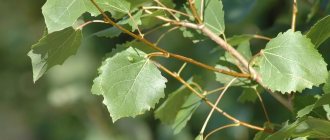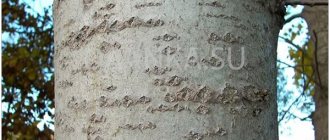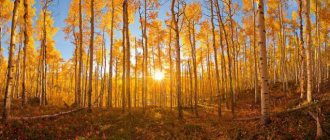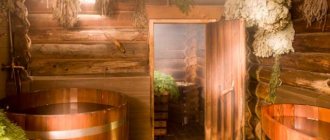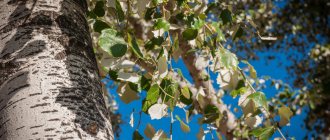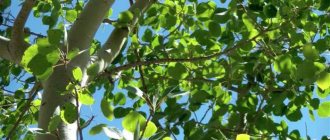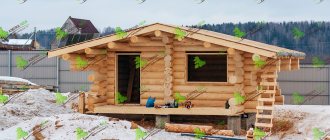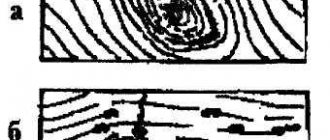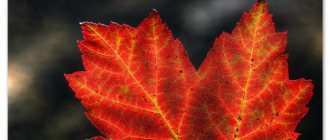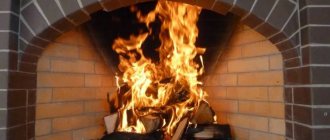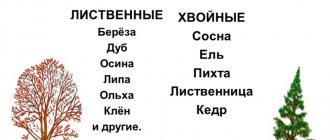Aspen (trembling poplar or lat. Populus tremula) is a tree of the Willow family. There are 3 genera in the family: willow, choicenia and poplar. Aspen belongs to the poplar genus. The tree is often mistaken for other members of its genus. It is not uncommon to try to distinguish aspen from balsam, black or silver poplar. In addition, in the forest you can confuse aspen with alder and linden, and at dusk - even with birch. What also makes it difficult to determine is that poplars easily cross-pollinate and form interspecific hybrids. It is possible to distinguish aspen from other trees only through a comprehensive comparison of morphological features.
Differences in bark
Birch is the only tree in the world with white bark. It is difficult to confuse it with other plants.
Due to growing conditions, it can acquire a greenish, yellowish, and in rare cases red and even black tint.
Another difference is the presence of black lentils and raised cracks.
Aspen bark is green-gray and can fade to beige or blue. At the bottom it is usually rough. May have deep cracks. In the middle part of the trunk, it is smooth and has a green tint.
When splitting aspen firewood, the bark comes off in large pieces. Birch bark is thin and soft. Its top layer is birch bark, consisting of many thin layers. This is the most significant difference.
Wood species for firewood
For heating a stove or fireplace, hardwood is most often used, which burns for a long time and has good heat transfer. Among them, the first place is occupied by oak firewood, followed by birch, alder, linden, ash and others. In addition to them, firewood cut from fruit trees performs well. Such wood is very often used for smoking products, as it has a special aroma.
Conifers also burn well, but give less heat transfer and a large amount of soot due to a very high percentage of resin.
By the leaves
Aspen leaves are dark green. The shape is close to a circle. The part of the leaf facing the sun is glossy, rich green. The back side is matte, as if slightly dusty.
The leaf is attached to the branch by a long thin stalk. Because of this, aspen leaves tremble violently in the wind. In autumn they turn yellow, and in some varieties they turn red.
Birch leaves are much smaller. They are easy to distinguish from the rest. The shape is classic, with serrated edges. Young leaves are bright, juicy, green. Then they fade a little. In spring, the leaves are sticky and slightly stick to your hands.
Identify by flowers
Yes, yes, don’t be surprised, both the birch and aspen are blooming. Only the flowers are not ordinary.
Earrings are birch flowers. They appear during the fruiting period. They consist of scales fused in the center, 2-4 cm long. In early spring they are green, and with the arrival of warmth they turn brown.
Aspen also has flowers. They are collected in earrings. A characteristic fluff is visible between the seeds. They are red, up to 15 cm long. And green - they are thinner and shorter.
By fruit
Trees can also be distinguished by their fruits.
Aspen has elongated boxes consisting of 2 or 4 leaves. Inside there are many small seeds with a puff. Aspen blooms in late May early June.
The birch fruit resembles a nut with thin wings. The fruits are very light and small. 5000 nuts weigh 1 gram. They are easily carried by the wind. They can often be seen around birch trees, especially in winter.
Distinguish by branches
The branches of the birch are thin and look like a cobweb. Hanging branches do not have their own rigidity at all. The color of the thin branches is dark, one might say black.
They bend beautifully. They are used to weave wreaths and are actively used as bath brooms.
Aspen branches are very different. They are thick, dense, and not at all elastic. It is difficult to bend an aspen branch; it is easier to break it. They do not differ in color from the trunk.
By juice
In the spring, before the leaves bloom, an active process of sap movement occurs inside the birch. It is popularly called birch tree. It is loved and collected by many people. It has a pleasant sweet taste. If you make an incision on the trunk in the spring, sap will begin to flow out.
Aspen also has sap flow. But not so much. Aspen sap is bitter. And it has no culinary or medical significance.
For mushrooms
If you like to pick mushrooms, then this will also help differentiate the two trees.
There is an opinion that mushrooms grow under a certain type of tree. So aspen boletus grows near aspens, and boletus grows where birch trees grow.
This popular observation has a right to life. But you shouldn’t strictly focus on it.
price/practicality rating
Despite the widespread distribution of aspen in temperate latitudes, many people constantly confuse this species with others - especially with poplars. Even knowing the main differences between aspen and poplar, recognizing these plants can be difficult, especially for novice gardeners. Moreover, aspen trees are surprisingly tenacious, and it can be very difficult to exterminate such “unplanned plantings” on your site.
The aspen tree (Populus tremula) is the closest relative of poplars. The Latin name of aspen translated into Russian means “trembling poplar.” The leaves of the aspen tree are indeed “trembling.”
A small breath of breeze - and all the foliage begins to move. Why does this happen? This, as well as how to recognize an aspen tree, as well as how to distinguish an aspen from a poplar, will be discussed below.
Hardwood firewood
To make a choice, you need to consider each type of firewood separately.
Birch firewood
This type of wood has special qualities, which is why it is often used to fire baths. The heat that birch gives is a disinfectant for the room and releases the fragrant aroma of a real Russian bath. In addition, it is also credited with medicinal properties that help speedy recovery during a cold. But birch firewood cannot be kept in woodpiles for more than two years - it loses its properties and begins to deteriorate, turning into dust.
Dried birch wood, as well as its bark, has a high content of tar, which is a carbon compound, so firewood quickly ignites and burns together, without leaving behind a large amount of ash. Splinters made from dry birch logs are used to light other firewood made from heavier wood. When burning, birch gives off good heat transfer, releasing heat of such intensity that is 22 - 25% higher than the flame from aspen or pine wood.
Oak wood for heating a stove is considered an elite fuel, so it is quite expensive. Oak is a hard wood, it burns for a long time and has very good heat transfer, surpassing even birch firewood in this quality. For heating, middle-aged trees are harvested - they are the ones that have the properties described above. Oak firewood produces intense heat and spreads a tart forest aroma throughout the heated room, and this is especially felt if they are used to stoke a fireplace. The steam released by oak when burned, just like birch, has long been considered medicinal by people, especially for children.
It is interesting that famous Italian restaurateurs and cafe owners, adhering to ancient traditions, use exclusively oak firewood to prepare real pizza, although such wood is rare and has a fairly high price. Firewood from the trunks of fruit trees, such as a pear or an apple tree of a certain age, has somewhat similar qualities, but it is quite difficult to find them in large quantities.
Alder firewood
Alder firewood is popular because it does not require special conditions for drying - it reaches the required humidity on its own. This happens because those alder trees that grow in places where the soil does not have excessive moisture are selected for firewood. Such wood can retain its aromatic properties for more than three years, and also does not lose its other positive qualities. These include excellent heat transfer and low resin content - thanks to this quality, it produces less smoke when burning. Therefore, alder firewood has long been often used in baths that are heated in black. Another good quality of this wood is that the evaporation from it helps clean the chimney of soot deposits.
Alder has more than 25 species, and each of them has its own shade - beige and brown, bright red and almost white. By this feature, it can be easily distinguished from other wood.
If alder is sawed in the yard of the house, then you must place a piece of fabric or polyethylene under the sawing site to collect all the sawdust. They are useful for smoking meat and fish dishes, and it is also good to add them to the grill when preparing barbecue.
Aspen
Aspen firewood, just like alder, helps clean soot deposits in the chimney. The flame from this firewood itself does not produce soot, but the rising aspen heat makes the soot already accumulated in the chimney loose, and it begins to separate and crumble into the firebox.
However, they also have a huge drawback - aspen firewood burns quickly, giving low heat transfer, so they are not popular and are rarely used, mainly for kindling or cleaning the stove.
Linden wood, although it burns slowly, gives excellent heat, and therefore good heat transfer. Almost any linden components - leaves, color, bark and wood - are medicinal. Therefore, such firewood was often used in baths - a little honey was added to it, which gave a unique thick aroma to the steam room, which was used to treat lung diseases or long-lasting wounds. After a bathhouse heated with linden wood, the patients were given tea with linden blossom and honey - it cleanses the respiratory system and also removes toxins from the body.
The disadvantage of linden firewood is their short shelf life - no more than two years.
What an aspen tree looks like and what leaves it has (with photo)
Aspen is a tree from the willow family, 15–20 m high. In good conditions, aspen reaches larger sizes. The crown of an aspen tree looks like a giant, openwork “egg.” The bark of the trunks is predominantly gray, but there are aspens with greenish bark, and in Eastern Siberia and Mongolia they are almost white-barked; from afar they can be mistaken for birch trees.
The bark is smooth, only in old trees with longitudinal cracks.
The plant has round leaves that are colored first bronze, then green, and with the onset of autumn, bright yellow.
The tree blooms in late April or early May - before the leaves bloom. The aspen root system is flat and demanding of soil.
Look what an aspen tree looks like in these photos:
The tree copes well with any frost and is also not afraid of winds. Perfect for park areas.
In the first years of life, it is characterized by vigorous growth: annual shoots can reach 3 meters. The growth rate of the tree is high only in the first years, approximately 60-80 cm, but then it drops and is about 20-40 cm per year. Aspen lives on average 80-100 years; individual specimens are known at the age of 150-180 years. Its trunk usually has rot inside at an early age; adult trees are almost all rotten in the middle. Such trees are easily broken by strong winds.
What kind of leaves does aspen have, and why do they “tremble”?
This is explained by the fact that the leaf blades are attached to the end of a long and thin petiole, which has an unusual shape - it is not cylindrical, but flat, strongly flattened laterally. Thanks to this shape, the petiole bends especially easily to the right and left. This is why the leaf blades are so mobile: they begin to oscillate in one direction and the other even with a very weak breeze.
Aspen leaves vary greatly in shape depending on the age of the plant. As you can see in the photo, the leaves of an adult aspen tree are round:
But look at the very young aspen trees that appear in the forest and do not exceed half a person’s height in height. Their leaves are completely different - elongated-oval with a gradually tapering sharp end. They are more like poplar leaves. Looking at the shoots with such leaves growing from the ground, not everyone will guess that these are young aspen trees.
These photos show what aspen leaves look like:
In winter, the thin branches of the tree do not stand out as anything special. Their buds have no special features, nor do the branches themselves. But you can unmistakably recognize young aspen branches if you lightly chew them. They have a rather strong bitter taste and a peculiar smell.
The following describes how poplar differs from aspen and how these trees are similar.
Firewood from fruit trees
Firewood from fruit trees
Such firewood is suitable for heating a house, but the wood of old trees is used for this, as well as for a bathhouse or fireplace. They burn well, have a light aroma, and do not produce strong burning when burned. This wood is often used for smoking meat and fish, as well as for making barbecues and kebabs.
How to recognize aspen: how does this tree differ from poplar
What makes aspen classified as close relatives of poplars? Let us recall that botanists consider plants to be related if their flowers and fruits are similar in structure. This is precisely what is evident from the description of aspen and poplar. The flowers of all these trees are small, inconspicuous, collected in dense cylindrical earrings, which hang from the branches of the tree during flowering.
Look at the aspen in the spring when it begins to bloom.
On some trees you will see bright red catkins, on others - green. The former consist of many male, staminate, flowers, the latter - of female, pistillate flowers. The same can be seen with poplars.
The fruits of aspen and poplar are very similar in description: in both trees they are small, about the size of a grain of wheat, elongated oval boxes. When ripe, the capsule cracks into two longitudinal halves and releases the seeds inside it.
The seed is so small that it is barely visible to the naked eye. It is surrounded by many fine hairs. Spilling out of the boxes, the seeds fly through the air for a long time, like white fluff. Poplars also produce the same “fluff” in abundance in our cities.
Aspen is a tree in which you can observe the interesting phenomenon of autumn branch fall. Come to the forest in late autumn, look at the ground under some old aspen. If you take a closer look, you will see that here and there under the tree there are thin branches of different lengths lying around - both short, as long as a pencil, and longer. These twigs are alive, not withered, the leaves have just fallen from them. At the end of each there is a pointed bud. If you break it, you can see the green rudiments of future leaves inside. Next spring this bud could bloom normally.
Why did living aspen branches end up on the ground, and how did they break away from the tree?
To answer this question, you need to look at the end of the branch where it broke off. The fracture surface is smooth, rounded, similar to the head of a nail. There was no damage here. The branch separated from the tree by itself and in a very specific place. Just like a yellowed leaf in autumn. This means that the tree is deliberately getting rid of some branches.
Below you will find out where the aspen tree grows and how it reproduces.
Characteristics of firewood
It is not always appropriate to compare heating a house with a stove and electricity or gas, since the stove additionally creates an atmosphere of comfort and unique family coziness. How pleasant it is to hear the soft crackling of firewood in the hearth in the silence of the doom, to feel the warmth emanating from it. Even in our time, these unique feelings are so pleasant to people that a high-quality stove or a good fireplace is built in almost every private home.
However, in order to effectively use the capabilities of the stove, you should understand firewood. It turns out that not all tree species are equally good for burning; there are many nuances that significantly complicate the choice of firewood for the stove.
For example, for burning in a fireplace, it is advisable to find wood that, when burned, emits a pleasant aroma, but does not emit a large amount of resin, soot, or soot. Resins in wood contribute to increased smoke output, as well as explosive cracking of logs with the release of large coals. Such emissions will be unsafe for an open fireplace, so coniferous wood is not used in them.
Firewood for the stove is selected based on heat transfer; its main criteria are the intensity and duration of combustion. It is desirable that the wood burns with less smoke and leaves behind a minimum of ash.
If we consider the optimal firewood for use in a stove, then it should have the following functionality:
- First of all, heat transfer is the maximum possible for wood.
- The flammability of the wood must also be excellent, so that lighting a fireplace is not difficult.
- When burned, firewood should not emit a lot of smoke and leave behind a small amount of ash.
To achieve such characteristics, it is important not only to choose the right type of wood, but also to properly dry the harvested timber and ensure its normal storage. Freshly cut wood is not used in kilns; to prepare it, it should be dried for some time, getting rid of excess moisture. Wet wood burns weakly and produces a large amount of smoke.
There is even a method for determining whether firewood is dry enough for use in fireplaces or stoves. You should hit one log against another and listen to the sound. If it is sonorous, then it is quite possible to use such logs for heating the hearth.
It is believed that the best firewood for fireplaces and stoves is obtained if logging is carried out in the winter. At this time, the trees are in a certain preserved state, as a result of which sap flow practically does not work in them. The worst thing is if the firewood is collected in the spring or summer, when the wood contains a large amount of moisture, such wood will dry out for a very long time.
Where does the aspen tree grow: distribution area (with photo)
The distribution area of aspen is the temperate zone of Eurasia and the mountains of North Africa. A significant part of the range is in our country. In Russia, aspen is distributed almost everywhere. In the north it reaches the border of the forest with the tundra, in the south it reaches the dry steppes. In the forest-steppe it forms island groves, the so-called “aspen groves”. In saline areas it takes on a bush-like form. In the Alps it rises to mountains up to 2,000 m above sea level. Almost everywhere, aspen forms, as a rule, pure forests, with only a small admixture of other species in the upper layer. It is very light-loving, so where other species shade the aspen, it dies. Aspen itself often acts as an admixture in birch forests or in cleared areas of other forests.
These photos show where aspen grows in temperate latitudes:
Aspen forests most often appear on the site of oak and spruce forests destroyed by humans or destroyed by fire. Such aspen trees live relatively short - 80-100 years. They are light, which allows undergrowth of native species (oak, spruce, etc.) to grow successfully under their canopy, even if it is not shade-tolerant. Over time, the native tree species grown under the aspen canopy overtake the aspen in growth, shade it, and it dies, giving way to its stronger competitors. Thus, aspen plays an important biological role - preserving the forest area. Where aspens grow, oak and spruce forests are quickly restored.
Firewood stand
A firewood stand next to the fireplace is needed not only for interior decoration - it is intended for storing and drying a batch of firewood for one or several fireboxes.
Firewood, laid out in advance on a stand, will dry well by the time of combustion
Typically, the bulk of wood is stored outdoors. Even if the woodpile is slightly covered on top, this will not save it from moisture from the surrounding atmosphere and from the hot sun. Throughout storage, the stack either gets wet or dries out, and it is not known what the firewood will be like when it is decided to light the fireplace. Therefore, firewood is brought into the room in advance, and as it dries, it will emit a healthy, aromatic smell of the forest and decorate the interior with its picturesque appearance. At the right time, the required amount of firewood will be ready to light the stove. Having used them, you need to immediately replenish the stand with a new batch.
Aspen propagation
The breeding features of aspen are interesting. Its seeds quickly lose their viability after falling out of the fruit, within a few days. Therefore, seedlings can only appear if the seeds immediately fall on moist soil. It is on the soil, and not on the layer of fallen leaves, since the weak roots of the seedlings will not be able to break through it. For seedlings to emerge, bare soil and sufficient moisture are needed. But this does not happen everywhere in nature and not at any time. Therefore, young aspen trees emerging from seeds are not very common. They can be seen, for example, on abandoned arable lands, exposed slopes near roads, etc. They are almost never found in the forest.
But how does aspen reproduce in the forest?
If you go into any forest where there are mature specimens of this tree species, here and there you can see young aspen trees with the “poplar” leaves that are already familiar to us. Their height is small - barely knee-high for a person. Where did they come from? To answer this question, you should dig up the ground around the stem of some aspen tree. An interesting detail will emerge: the plant sits on a rather thick (pencil or larger) root, which extends horizontally and runs near the surface of the soil.
This root stretches a long distance in both one and the other direction. If you take the time to dig up the root, you can make sure that it starts from a mature tree. So, young aspens in the forest are nothing more than shoots that grow from the root of an adult tree. These are the so-called root suckers.
Up to a dozen or more root shoots can form on one root. They are located on the root, like beads on a string, but are separated from each other by a considerable distance. Some of them move 30-35 m away from the parent plant. At such a distance in a dense forest, you cannot always see the mother aspen behind other trees. Sometimes you don’t immediately understand where this or that offspring came from, or where the tree that gave it its beginning is located.
Thus, in the forest, aspen reproduces almost exclusively by root suckers, i.e. in a vegetative way. In forest conditions, this is much more reliable than propagation by seeds.
Characteristics of firewood
In order to choose the right type of wood for the firebox, you need to know some of its characteristics. Firewood is distinguished by heat transfer, flammability, ash content and the amount of smoke it produces when burning.
High-quality firewood is distinguished by good combustibility and heat transfer, the ability to produce a minimal amount of ash and avoid excessive smoke. To choose exactly these, you need to pay attention not only to the type of wood, but also to its dryness, since it must contain a certain percentage of moisture. Everyone knows that logs cut from a freshly cut tree will burn poorly due to excess moisture in them. Therefore, the preparation of firewood, and wood for outbuildings, furniture making and other needs, is usually carried out in the middle of the winter period. At this time, the trees “sleep”, and their trunks do not have such intense sap flow as, for example, in spring or summer.
Application of aspen
Aspen forest is the favorite food of elk. Beavers, the most valuable fur-bearing animals, also feed on aspen. Birds, especially woodpeckers, also need aspen. The fact is that with age this tree often develops heart-shaped rot. That's why foresters cut it down. However, in this same rotten misfortune lies the dignity of aspen as an indispensable component in the forest biocenosis. The affected tree is easily chiseled. Woodpeckers use such trunks to make hollows. Every year they make homes for themselves - this is their character. The old ones are inhabited by other inhabitants of the forest: owls, clints, starlings, mynas, hoopoes, whirligigs, tits, flycatchers, redstarts and bats. Bees also visit the aspen: it gives them a lot of pollen and glue.
Although aspen had a bad reputation, it was constantly used in everyday life in Russia. “Aspen stake” means the worst. But it was precisely this stake that peasants often used on their farms. From time immemorial, well log houses and cellars in the countryside were made not from pine, oak, or birch, but from aspen, the wood of which is not afraid of dampness. And how many ancient monuments have survived to this day thanks to the same aspen!
Aspen wood is widely used in carpentry, turning, and paper making. Especially prized is “aspen chock” - a material for making match straws. Tar, vinegar and tannins are extracted from aspen wood and bark. Ash is prepared from the bark, which is used to finish canvas, and yellow paint is extracted for the textile industry.
And who doesn’t know Khokhloma products - jugs, cups, ladles, spoons, dishes. All this is made from aspen. Artificial flowers are also made from aspen shavings. Viscose silk, plastic, methyl alcohol, acetone and many other products are obtained from aspen.
Aspen is completely unsuitable for firewood: it produces little heat. Aspen wood is used primarily for matches. Chips are also made from aspen to cover roofs.
Aspen is also used to produce feed yeast, which is added to the diet of farm animals. This contributes to their productivity and accelerated development. As a honey plant, aspen is considered a secondary plant.
Aspen has not found application in scientific medicine. People use it quite widely for medicinal purposes. Buds, leaves, and bark are used for medicine. Aspen also heals from various ailments.
The bitterness, essential oils, organic acids, glycosides, and tannins found in its buds, leaves and bark have anti-inflammatory, analgesic, wound-healing, diuretic, diaphoretic and other properties.
Alcohol extract of aspen buds has a bactericidal effect on some dangerous microbes (Staphylococcus aureus, Pseudomonas aeruginosa, enteric typhoid bacteria). It is better to harvest buds from young trees in the spring - in April-May.
In more southern regions, aspen causes significant damage to forestry. After cutting down a valuable oak forest, it quickly seizes the vacated area and no longer “allows” the oak there.
This often happens, for example, in the Tula abatis and in some forest-steppe oak groves. So aspen in forestry sometimes turns out to be a real weed and has to be fought hard.
The video below shows what this tree looks like and how it is used:
Softwood firewood
All coniferous wood is saturated with resins, so it burns very quickly, producing less heat than firewood from deciduous trees. However, when they burn in a steam room, an aromatic smell of pine forest appears, due to the high content of essential oils in them. This air helps cleanse the respiratory system and calms the nerves.
Larch firewood
If we compare pine with spruce, the former burns much hotter and faster, since it is looser and more resinous. Larch wood is the least enriched of conifers with resins and essential oils, but when burning it emits a large amount of carbon monoxide. Therefore, if you use it in a bath, you need to act very carefully.
When burning, coniferous wood tends to shoot out embers, so it is better not to use it for an open fireplace insert. The disadvantage of pine firewood is that when the resins burn, the chimney pipe becomes clogged quite quickly.
